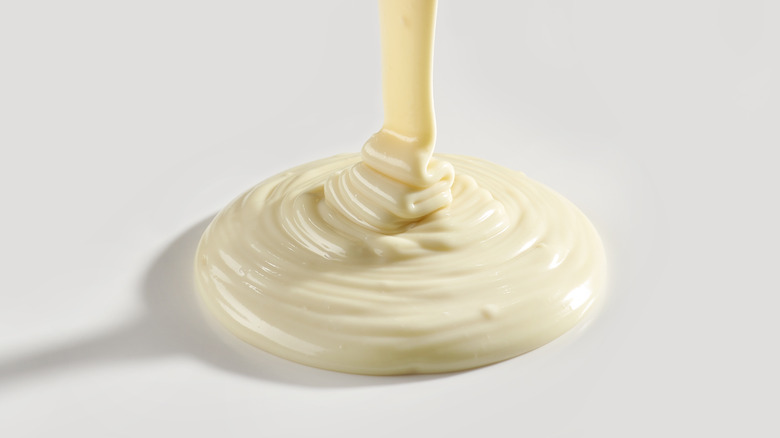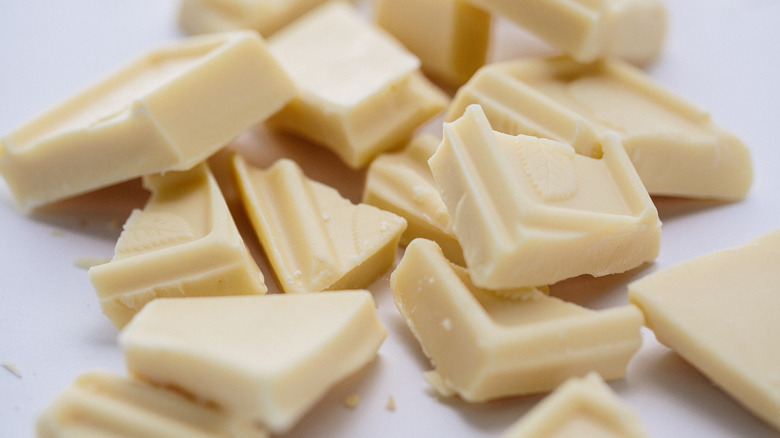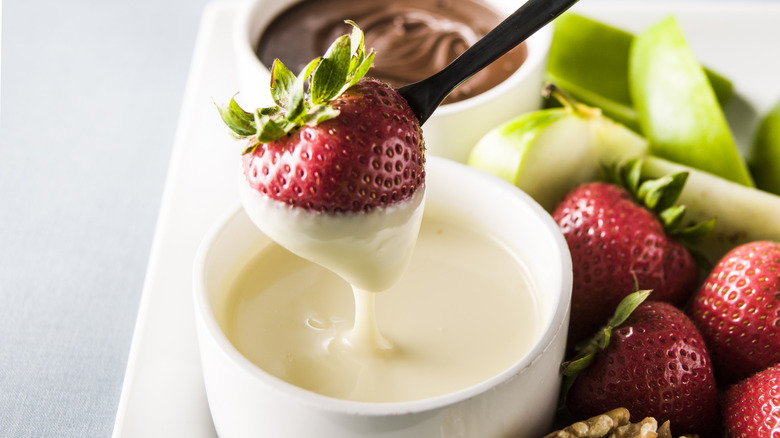Melting White Chocolate? Stop Making This Mistake
Plenty of people champion the joys of a high-percentage dark chocolate, while others prefer a bittersweet option, or the mild, nostalgic delights of milk chocolate. But there's so much to love about white chocolate, with its buttery, vanilla-like qualities, its luscious, ultra-creamy look, and major versatility. The question of whether white chocolate is actually chocolate has been put to rest (the answer is yes, at least in the U.S.), but because it's not as assertive as other chocolates, it's welcome in just about any sweet dish.
White chocolate is also especially useful in melted form, whether drizzled over warm popcorn or fresh blueberry muffins or scones, as a dip for juicy strawberries, or to enrobe your favorite cookies. But when it comes time to liquify this delightful stuff, you may have run into some trouble in the past.
One mistake can actually be avoided right in the baking aisle when you're deciding which format to purchase. If your recipe calls for melted white chocolate, there's one easy answer: Steer clear of white chocolate chips, and go for a bar instead. This simple selection will ensure that you'll have a smoother, creamier finished product, and save you from a potential culinary meltdown.
Why chips should stay on the shelf
The science behind this tip has to do with how white chocolate is commercially produced. Since it naturally has a lower melting point than other chocolate (thanks to its larger percentage of cocoa butter and dairy), smaller pieces — like chips — are more susceptible to softening and becoming a bag of mush when subject to the temperature fluctuation and rigors of transporting, stocking, and merchandising. As a safeguard, producers include stabilizers that help keep these bits in their perky shapes so that when you purchase them, they still resemble the chip you've been promised.
The issue is that those same stabilizers also prevent you from melting these pieces evenly and efficiently. Instead of becoming a silky, creamy and smooth ingredient when heated up, stabilized chips will be resistant to the transformation, and can yield clumps. When that happens, you may think you just have to cook it a bit longer or turn up the heat, but these strategies trigger another problem. White chocolate also has a lower burn temperature, and is more prone to becoming a gloopy and unsalvageable mess than its darker counterparts.
The solution is to reach for a bar of white chocolate instead. (If you've ever learned the tip for making sure your white chocolate doesn't overbake, this advice will be familiar.) You'll still want to chop it up into small pieces, to ensure a quick and even melt, but you won't run the risk of this stabilizer-hindered situation.
Preparing and using your white chocolate
When you start out with the right ingredient, melting white chocolate is a simple process that can be done one of two ways. You can either use a standard double boiler setup, or even head straight for the microwave. In either scenario, it's still super important to keep a close eye (microwave only for about 20 seconds at a time, and keep a double boiler on a gentle simmer), and don't try to speed the process up by using high heat. Patience will be rewarded.
While working with white chocolate requires a touch as delicate as the flavor itself, once you have that smooth and creamy melted version, you can enjoy the sweet and luscious flavor and depth it contributes to so many treats. Make white chocolate rainbow popcorn for a celebration of salty and sweet, creamy and crunchy. Try white chocolate-raspberry cheesecake bars, which incorporate white chocolate in two ways. Arrange a white chocolate fondue for the perfect date night. Armed with bars of white chocolate, some heat and a little inspiration, you'll have a whole lineup of delicious desserts on your hands.


